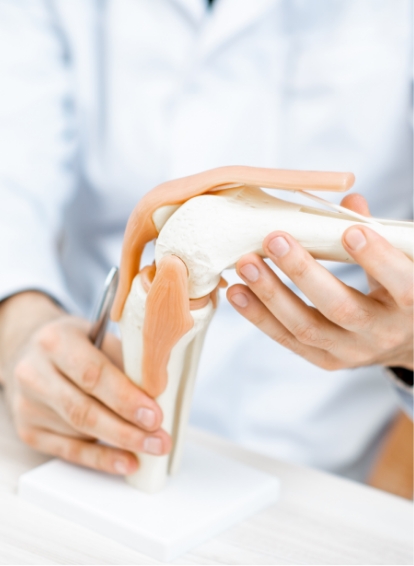Sports & Non-Surgical Orthopaedic Treatments
Ankle Pain
Ankle pain is a common issue that can stem from various causes, such as sprains, fractures, or underlying conditions like arthritis. This pain can range from mild discomfort to severe pain that limits movement and can interfere with daily activities, especially walking or standing.
At The Clinica, our specialists in Sports & Non-Surgical Orthopaedics provide comprehensive care for ankle pain, offering treatments that relieve discomfort, improve stability, and restore full function to support a return to everyday activities.

What is it?
Ankle pain refers to any discomfort or pain in the ankle joint, which connects the foot to the leg and is surrounded by ligaments, tendons, and muscles that provide support and stability. Injuries, such as sprains or fractures, are the most common causes of ankle pain, often occurring due to sudden twisting or impact during sports or other physical activities. Ankle pain may also result from conditions like arthritis, tendinitis, or gout, which can cause inflammation and stiffness in the joint.
Symptoms of ankle pain can vary depending on the cause, from sharp pain and swelling to a dull ache and reduced mobility. Individuals may experience difficulty putting weight on the affected ankle, and in cases of severe injury, visible deformity or bruising may be present. Persistent ankle pain can significantly impact mobility and quality of life, making it challenging to perform daily tasks comfortably.
An accurate diagnosis is essential to understand the cause of ankle pain and develop a targeted treatment plan to relieve symptoms and prevent further complications.
Book an appointment
If you are new to The Clinica or have not yet begun treatment with Dr. Williams for this condition, please note that an Initial Sports Consultation must be booked before proceeding with any specific service or treatment plan.
Additional Information

Causes of the condition
Ankle pain can arise from acute injuries, overuse, or chronic conditions affecting the joint. Sprains are among the most common causes, occurring when the ligaments around the ankle are stretched or torn, often due to a sudden twist or impact. Fractures, or breaks in the ankle bones, can result from falls or high-impact injuries and usually cause severe pain, swelling, and bruising.
Overuse injuries, such as tendinitis, develop gradually from repetitive stress on the ankle, commonly seen in athletes and individuals with physically demanding jobs. Tendinitis occurs when the tendons that support the ankle become inflamed, leading to pain and stiffness.
Arthritis, particularly osteoarthritis and rheumatoid arthritis, can also lead to ankle pain by causing inflammation, joint stiffness, and cartilage degradation over time.
Other factors, such as improper footwear, flat feet, or biomechanical issues, can place additional strain on the ankle joint, increasing the risk of pain and injury.
Tests that can be done to confirm the condition
Diagnosing ankle pain begins with a physical examination and an assessment of symptoms and medical history. The clinician will check for tenderness, swelling, and range of motion in the ankle and may perform specific tests, such as the “anterior drawer test” or “talar tilt test,” to assess ligament stability and identify possible sprains.
Imaging tests, such as X-rays, MRI, and ultrasound, are often used to confirm the diagnosis and determine the extent of damage. X-rays are useful for detecting fractures or joint abnormalities, while MRI provides detailed images of soft tissues, such as ligaments, tendons, and cartilage, helping to identify sprains or tendinitis. Ultrasound is particularly valuable for assessing inflammation in the tendons and detecting fluid accumulation within the joint.
In cases where arthritis or other inflammatory conditions are suspected, blood tests may be conducted to identify markers of inflammation or autoimmune disorders, which can help guide the treatment approach.
Effective treatments
Treatment for ankle pain focuses on relieving pain, reducing inflammation, and restoring joint function. Initial treatment often includes rest, ice application, compression, and elevation (the RICE protocol) to manage pain and swelling, particularly in cases of acute injury. Over-the-counter pain relievers may also be recommended to alleviate discomfort.
Physical therapy is an essential part of ankle pain management, focusing on exercises to strengthen the surrounding muscles, improve balance, and restore flexibility. Ankle strengthening exercises help stabilise the joint, reducing the risk of future injuries. Balance training is particularly useful for individuals with a history of ankle sprains, as it improves proprioception and helps prevent re-injury.
For chronic ankle pain or cases where inflammation persists, corticosteroid injections may be used to reduce swelling and provide temporary pain relief. For severe injuries, such as fractures or complete ligament tears, surgical intervention may be necessary to repair or stabilise the joint. After surgery, rehabilitation is crucial to restore mobility, strength, and stability.
Book an appointment for an initial consultation
Booking an initial consultation at The Clinica is the first step toward effective management of ankle pain. During this consultation, our specialist will conduct a comprehensive assessment, discussing your symptoms, reviewing your medical history, and identifying any activities that may contribute to the pain. A thorough physical examination of the ankle joint will help determine the location and severity of the pain.
If necessary, imaging tests such as X-rays, MRI, or ultrasound will be arranged to confirm the diagnosis and guide treatment. Following this assessment, a personalised treatment plan will be developed, focusing on pain relief, rehabilitation, and strategies to prevent recurrence, ensuring a structured approach to restoring ankle health.
Frequently Asked Questions
Recovery time depends on the cause and severity of the pain. Mild sprains may improve within weeks, while fractures or chronic conditions may require months of treatment and rehabilitation.
Yes, many cases of ankle pain improve with non-surgical treatments, including rest, physical therapy, and pain management techniques. Surgery is typically reserved for severe injuries, such as fractures or ligament tears.
Strengthening exercises that target the ankle and calf muscles, along with balance training, can help relieve ankle pain and improve stability. A physical therapist can provide specific exercises.
Imaging tests like X-rays, MRI, or ultrasound are often recommended to assess the extent of damage, particularly in cases of severe or persistent ankle pain.
Wearing supportive footwear, strengthening the ankle, and practicing balance exercises can help prevent ankle pain from recurring, especially for those with a history of sprains.
Specialised Clinics
General Enquiries
Please send your enquiry to us and our Practice Manager will be in touch shortly. Alternatively, if you would rather speak to us or your enquiry requires our urgent attention, please call us on 01344 946363.








